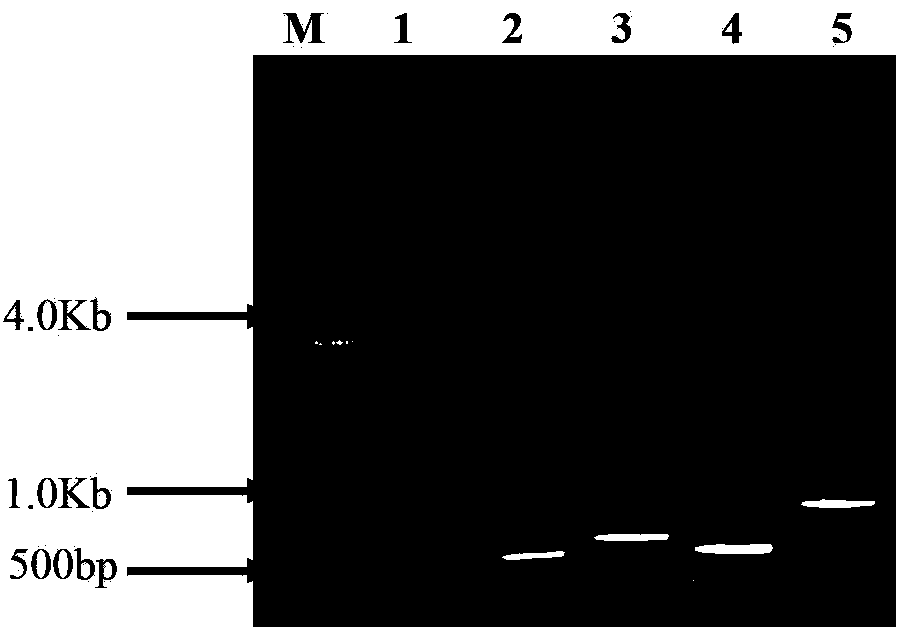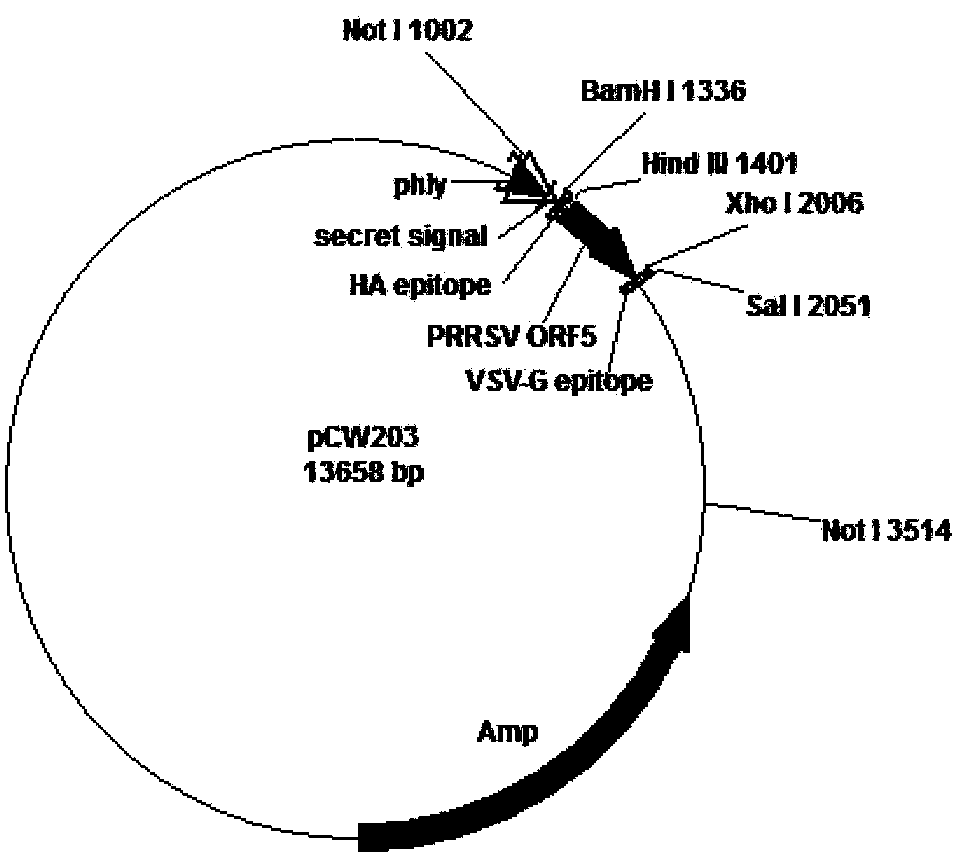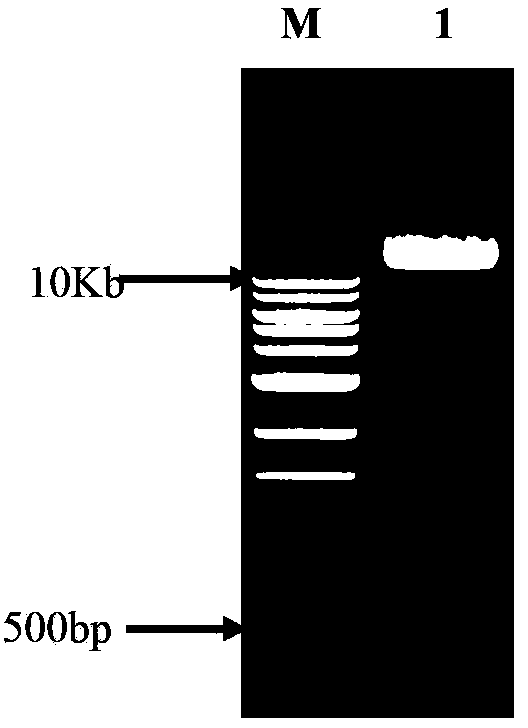Method for integrating exogenous gene into sheep listeria genome
A technology of Listeria and exogenous genes, which is applied in the field of integrating exogenous genes into the genome of Listeria ovis, can solve problems such as no public reports, and achieve wide application range, easy large-scale production, and simple and easy screening methods Effect
- Summary
- Abstract
- Description
- Claims
- Application Information
AI Technical Summary
Problems solved by technology
Method used
Image
Examples
Embodiment 1
[0071] Example 1: Preparation of the first recombinant plasmid pCW203
[0072] (1) Amplify the PRRSV envelope protein GP5 coding gene ORF5 gene fragment (GenBank: JX105430.1)
[0073] The recombinant plasmid pRK5-GP5 was used as a template for PCR amplification, and the reaction system was: 10×ultra pfu buffer 2.5μl, 4dNTPs (10mmol / L. species) 0.4μl, upstream primer (10μmol / L) (ORF5-f.5' -TATGTAAGCTTTGTT GGGGAAGTGCTTGACC-3') 0.8 μl, downstream primer (10 μmol / L) (ORF5-r5'-ATAACTCG AGGAGACGACCCCATT GTTCC-3') 0.8 μl, pRK5-GP5 0.75 μl, ultra pfu 0.25 μl, ddH 2 O19.5 μl. Reaction cycle conditions: 94°C for 3min → (94°C for 30s, 55°C for 30s, 72°C for 1min20s) × 20 cycles → (94°C for 30s, 66°C for 30s, 72°C for 1min20s) × 10 cycles → 72°C for 10min → 4°C . After the PCR product was subjected to 0.8% agarose gel electrophoresis, a specific band was seen at 620bp, which was in line with the expectation ( figure 1 ). The PCR amplification products were qualified by sequencing.
...
Embodiment 2
[0077] Embodiment 2: Preparation of the second recombinant plasmid pCW153 and the third recombinant plasmid pCW154
[0078] (1) Amplify Li orfXYZ (GenBank: AJ249805.1), Li mpl (GenBank: AY510073.1), Li orfBAldh (GenBank: AJ249805.1) and Ery (see the sequence in SEQ ID NO.2 (6642).. (8092)) gene fragment
[0079]Take the Li strain out of the -80°C refrigerator, melt it in a water bath at 37°C, and streak the BHI agar plate, culture at 37°C for 24 hours, pick the colony and transfer it to 5ml of BHI liquid medium, shake it at 220rpm at 37°C for 12-18 hours, use a general-purpose The column genome extraction kit extracts genomic DNA as a template to amplify Li orfXYZ, Li mpl and Li orfBAldh gene fragments. The reaction system for amplifying Li orfXYZ is: 10×ultra pfu buffer 2.5μl, 4dNTPs (10mmol / L. species) 0.5μl, upstream primer (10μmol / L) (Li orfXYZ-f: 5'-ATAAAGCTTGTCGACATACTAGTTTCCAGCAAAGCGATT C-3') 0.8 μl, downstream primer (10 μmol / L) (Li orfXYZ-r: 5'-AACTCTGCGGCCGCTTATTTT...
Embodiment 3
[0094] Example 3: Preparation of the first recombinant strain Li lacZ and the second recombinant strain LiΔactA lacZ
[0095] (1) Amplify the lacZ gene fragment (see (8192)..(12171) in SEQ ID NO.1 for the sequence)
[0096] Use the plasmid pHS-LV as a template to amplify lacZ by PCR. The reaction system is: 10×ultra pfu buffer 2.5 μl, 4dNTPs (10 mmol / L. species) 0.6 μl, upstream primer (10 μmol / L) (LacZ-f: 5'- ATAAGCGGCCG CTAGCTTTAAGGCTAAATGCCG-3') 0.8 μl, downstream primer (10 μmol / L) (lacZ-r: 5'-ATAAG-CGGCCGCCTAGAGTGACTTTATGTTGAG-3') 0.8 μl, pHS-LV plasmid sample 1 μl, ultra pfu 0.25 μl, ddH 2 O19.05 μl. The reaction cycle conditions are: 94°C 3min→(94°C 30s, 52°C 30s, 72°C 4min20s)×20 cycles→(94°C 30s, 70°C 30s, 72°C 4min20s)×10 cycles→72°C 10min→4 ℃. After the PCR product was electrophoresed on a 0.8% agarose gel, a specific band was seen at 4001bp, which was in line with expectations (see figure 1 ). The PCR amplification products were qualified by sequencing.
[00...
PUM
 Login to View More
Login to View More Abstract
Description
Claims
Application Information
 Login to View More
Login to View More - R&D
- Intellectual Property
- Life Sciences
- Materials
- Tech Scout
- Unparalleled Data Quality
- Higher Quality Content
- 60% Fewer Hallucinations
Browse by: Latest US Patents, China's latest patents, Technical Efficacy Thesaurus, Application Domain, Technology Topic, Popular Technical Reports.
© 2025 PatSnap. All rights reserved.Legal|Privacy policy|Modern Slavery Act Transparency Statement|Sitemap|About US| Contact US: help@patsnap.com



